| Home | Current show | Photography/Calligraphy | Show archives | Japanese pottery | Tea bowls | Sumi-e | Gallery tour | Wabi sabi |

Touching Stone Gallery Santa Fe New Mexico USA
www.touchingstone.com Email: director@touchingstone.com

Touching Stone Gallery Santa Fe New Mexico USA
www.touchingstone.com Email: director@touchingstone.com
Hiroyuki Wakimoto Legacy July 9 - August 11, 2004 |
|||
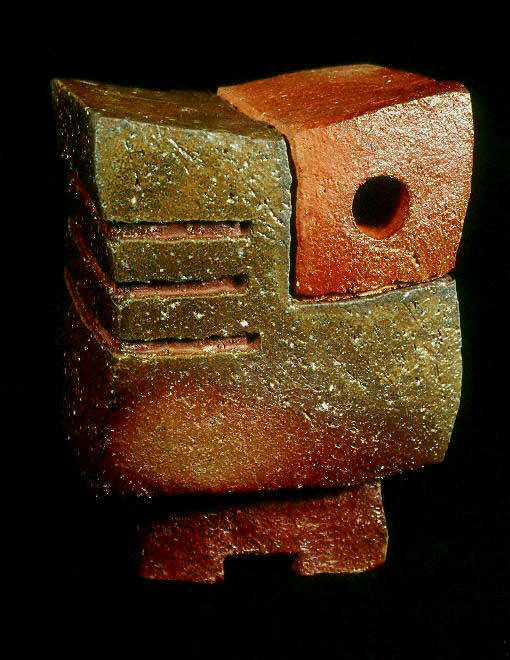 See more of this artist's work: 2002 show, 2003 show, 2004 show, 2005 show, 2006 show, 2007 show, 2009 show, 2010 show, 2012 show, 2016 show |
|||
|
Hiroyuki Wakimoto 脇本博之 Hiroyuki Wakimoto Hiroyuki Wakimoto was born in 1952 in Tsushima, Nagasaki Prefecture in Kyushu. He received art training studying textile design in Osaka Art College. In his senior year, realizing that his interests were not in textiles, he left the college and went back to his hometown. During a visit to a friend who was doing an apprenticeship with a ceramist in Bizen, Wakimoto found his true calling. He was so inspired by Bizen-yaki that, at the age of 30, he began an apprenticeship under accomplished ceramist Joji Yamashita. Nine years later, in 1990, Wakimoto built his own nobori-gama (climbing kiln) and established his studio in Bizen.As one of the six oldest Japanese pottery centers in Japan, Bizen has produced many exceptional ceramists, including a number of National Living Treasures. There is an enormous legacy for Bizen ceramists to live up to. Realizing that he must make up for his relatively late start in ceramics, Wakimoto concentrates on developing a personal style. His fascination with form compels him to create some of the most interesting works in contemporary Japanese ceramics. His pieces are instantly recognizable by the bold, meticulously conceived forms with clean strong lines and beautiful distinctive fire markings. Wakimoto’s extraordinary wood-fired ceramic works were first shown outside Japan in his American debut in 2002 at Touching Stone Gallery. In that show, Wakimoto introduced two dozen original pieces inspired by ancient Chinese bronze and ceramics. The show was enthusiastically received, and it firmly established Wakimoto as one of the rising stars among contemporary Bizen ceramists. Wakimoto's "Legacy" and "Sentinel" series are covered vases that evoke mythical beings with minimalist sensibility, reminiscent of certain sculptures by Isamu Noguchi. His incense burners in the show are interesting variations of the vase forms. The show also includes his composite pieces of the "Monarch" and "Stone" series, inspired by the massive stone walls of Japanese castles and natural stones. The separate components of the composite pieces were fired in different locations of the kiln to produce contrasting colors and textures. Each piece becomes a unique expression of the artist’s collaboration with the wood fire. Many of the pieces in this show are sculpted from chunks of clay rather than thrown on a potter’s wheel. The former technique, called "kurinuki", offers great freedom and flexibility for creating unique shapes. Reflecting on the evolution of his style, Wakimoto recalled, "In the beginning, I cared too much about making my work unique, and my hands struggled with the clay. Then one day, I just set my hands free to express my honest feelings without thinking too much about it. From that day, I felt relaxed and my work became spontaneous". Producing such a wide range of forms and effects requires not only creativity, but also intimate knowledge of the kiln. As an essential step in his creative process, Wakimoto keeps a record of new ideas as well as details of each firing, including data on temperature and exact position of each piece in the kiln. This methodical approach frees the artist from haphazard guesswork, allowing him to focus on turning abstract visions into tangible forms. Despite his soaring reputation, Wakimoto keeps his sense of humility. In a recent interview, the artist mused, "As an outsider who arrived at Bizen almost by chance, I was taught everything about Bizen-yaki that had taken hundreds of years to develop. I hope someday I can contribute my share of knowledge to the continuous evolution of Bizen-yaki as a way of repaying the generosity of my adopted home-town". The refreshing boldness and uncompromising quality of Wakimoto’s work is already making an impact in the Japanese ceramic circle, ushering a new era of creative energy in this ancient pottery center of Bizen. |
|||
| Click on images to view
selected pieces Inquiry/order: director@touchingstone.com |
|||
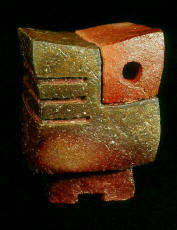 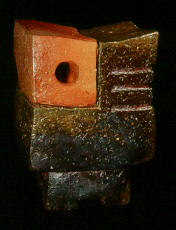 |
|||
| "Legacy #1" Covered ceramic vase 9" x 6.5" x 4" (2 views) Sold |
|||
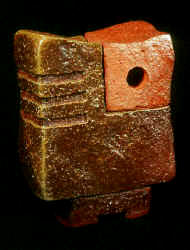  |
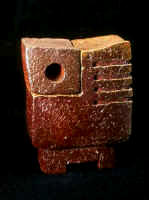 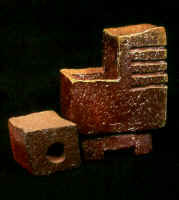 |
||
|
"Legacy #2" Covered ceramic vase 7.5" x 5.5" x 2.5" (2 views) Sold |
"Legacy #3" Covered ceramic vase 6.5" x 5" x 3" (2 views) Sold |
||
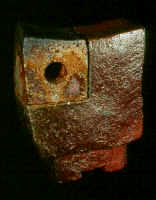 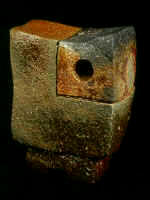 |
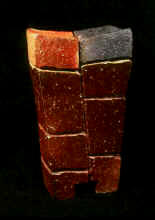 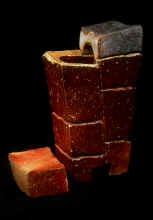 |
||
|
"Legacy #4" Covered ceramic vase 7" x 5.5" x 2.5" (2 views) Sold |
"Monarch #5" Covered ceramic box 8" x 4.5" x 3.5" (2 views) Sold |
||
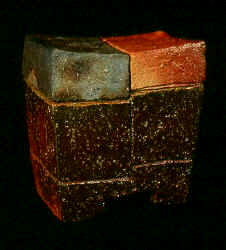 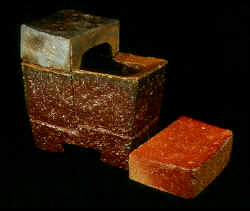 |
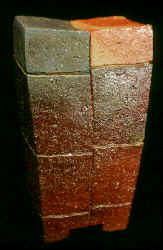 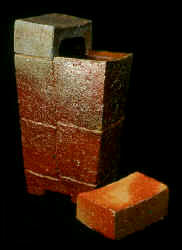 |
||
|
"Monarch #9" Covered ceramic box 6" x 6" x 4" (2 views) Sold |
"Monarch #21" Covered ceramic box 12" x 6.5" x 4.5" (2 views) Sold |
||
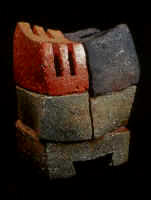 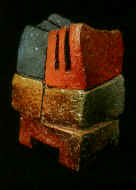 |
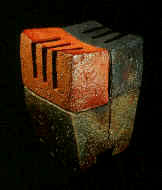 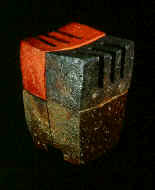 |
||
|
"Incense Burner #7" Ceramic incense burner 6" x 4" x 3" (2 views) Sold |
"Incense Burner #8" Ceramic incense burner 5.5" x 4" x 3.5" (2 views) Sold |
||
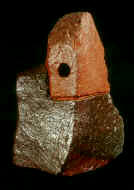 |
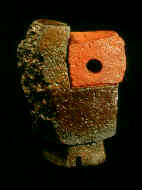 |
||
|
"Sentinel #4" Covered ceramic vase 7.5" x 4.5" x 4" Sold |
"Sentinel #5" Covered ceramic vase 7" x 5" x 3" Sold |
||
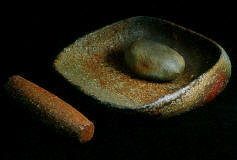 |
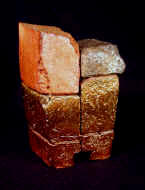 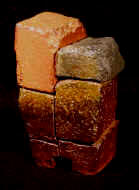 |
||
|
"Mano & Matate #19" Ceramic 'stone' tools 2" x 8" x 7.5" Sold |
"Sentinel #6" Covered ceramic vase 8" x 5" x 4" (2 views) Sold |
||
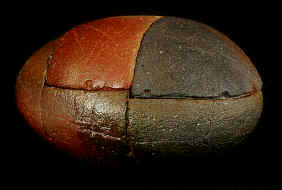 |
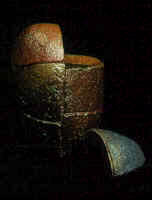 |
||
|
"Stone #11" Covered ceramic bowl w/ inscriptions 5" x 9" x 6" Sold |
"Stone #12" Covered ceramic bowl 5" x 3.5" x 2.5" Sold |
||
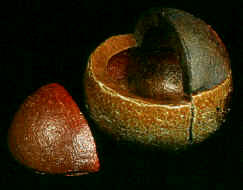 |
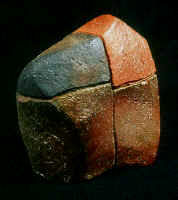 |
||
|
"Stone #10" Covered ceramic bowl 5.5" x 5.5" x 5.5" Sold |
"Stone #13" Covered ceramic bowl 6.5" x 5" x 3.5" Sold |
||
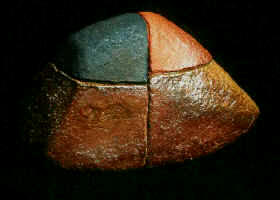 |
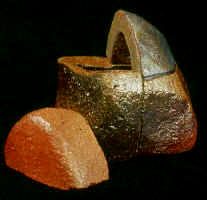 |
||
|
"Stone #14" Covered ceramic bowl 6" x 5.5" x 4" Sold |
"Stone #15" Covered ceramic bowl 4.5" x 7.5" x 4" Sold |
||
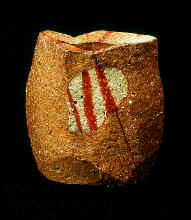 |
 |
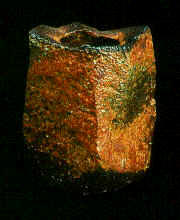 |
 |
| "Hanging Vase
#18" 4" x 4" x 2" Sold |
"Hanging Vase
#16" 13.5" x 2.75" x 2.5" Sold |
"Hanging Vase
#20" 5.5" x 5" x 3" Sold |
"Hanging Vase
#17" 16.5" x 2" x 2" Sold |
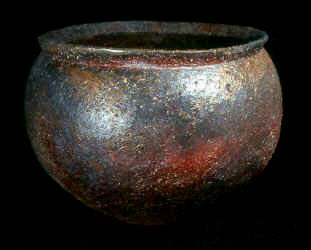 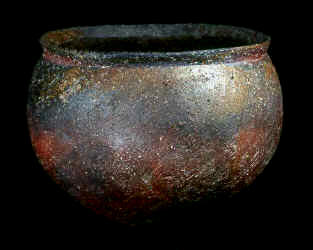 |
|||
| "Jomon #1" Large ceramic bowl 8.75"H x 11.5" D (2 views) Sold |
|||
|
Exhibitions & Awards 1952 Born in Tsushima, Nagasaki Prefecture, Kyushu 1975 Osaka Art College 1981 Apprenticeship under Bizen ceramist Joji Yamashita 1990 Established own kiln in Bizen Honorable Mention, 52nd Itt-sui Kai Ten 1991 8th Cha-no-yu no Zo-kei Ten, Tanabe Museum 2nd Biennial Ceramic Exhibition 38th Japan Traditional Arts & Crafts Exhibition 1st Yaki-shime Ten Honorable Mention, 53rd Itt-sui Kai Ten 1992 9th Cha-no-yu no Zo-kei Ten, Tanabe Museum 30th Asahi Ceramics Exhibition 39th Japan Traditional Arts & Crafts Exhibition 54th Itt-sui Kai Ten 1993 Honorable Mention, 3rd Biennial Ceramic Exhibition 31st Asahi Ceramics Exhibition 36th Japan Traditional Arts & Crafts Exhibition, China Branch Asahi Contemporary Arts & Crafts Invitational Exhibition 1994 11th Cha-no-yu no Zo-kei Ten, Tanabe Museum Grand Prize, 2nd Yaki Shime Juried Show Chairman’s Award, Japan Arts & Crafts Exhibition, Chu-goku Chapter 1995 12th Cha-no-yu no Zo-kei Ten, Tanabe Museum 13th Japan Ceramics Exhibition 42th Japan Traditional Arts & Crafts Exhibition 1996 13th Cha-no-yu no Zo-kei Ten, Tanabe Museum 34th Asahi Ceramics Exhibition 1997 14th Cha-no-yu no Zo-kei Ten, Tanabe Museum 35th Asahi Ceramics Exhibition 44th Japan Traditional Arts & Crafts Exhibition Nominated as a permanent member of Japan Arts & Crafts Association 1998 15th Cha-no-yu no Zo-kei Ten, Tanabe Museum 1999 37th Asahi Ceramics Exhibition 2000 3 - 4 shows every year in Tokyo, Osaka, and Kobe 2002 Touching Stone Gallery, Santa Fe, New Mexico 2003 Kuroda Toen Gallery, Tokyo Tenmaya, Takamatsu Touching Stone Gallery, Santa Fe, New Mexico 2004 Kuroda Toen Gallery, Tokyo Tenmaya, Fukuoka Touching Stone Gallery, Santa Fe, New Mexico Invited artist, Santa Fe International Folk Art Market 2004
Publications 2002 "Omen" - An article on Hiroyuki Wakimoto's work, by Tim Wong & Akko Hirano. In: Ceramics: Art & Perception, no. 48, pp. 97 - 99. |
|||